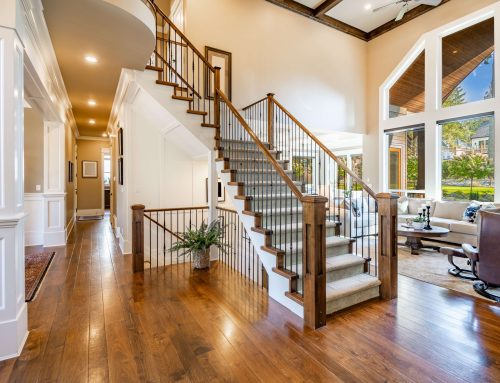Wood floor refinishing requires meticulous attention to detail to achieve a flawless finish and avoid sanding mistakes. Sanding a wood floor is essential in refinishing, but it must be done correctly. However, if executed improperly, it can lead to costly errors and less-than-satisfactory results. You must know the common mistakes to ensure your wood floor sanding project runs smoothly.
One of the primary things you must remember to avoid mistakes in wood floor sanding is to prepare appropriately. Still, one of the most common mistakes people make is not preparing better. Before sanding, remove all furniture, rugs, and other objects from the area. This will help you work quickly and keep the sanding tools from breaking.
Additionally, cleaning the floor thoroughly ensures no dirt or debris interferes with the sanding process, resulting in a smooth finish. Another mistake to avoid is using the wrong sanding grit progression. It is essential to start with a coarser grit to gradually remove the existing finish and then progress to finer grits for a smoother surface.
Skipping grits or spending less time on each determination can leave behind visible imperfections that are difficult to rectify later. You can achieve uniform sanding consistency by following the proper grit sequence.
By understanding and implementing proper techniques, you can transform your worn-out floor into a stunning centerpiece of your space. This blog will discuss how to avoid mistakes in wood floor sanding and provide valuable insights on avoiding them.
Neglecting Proper Preparation
One standard error to avoid when sanding wood floors is failing to prepare the surface adequately beforehand. Most people should remember the importance of moving furniture, rugs, and other items. It interferes with the sanding process and can cause unexpected equipment damage.
By adequately preparing the floor, you can avoid mistakes and achieve the best results when sanding a wooden floor. However, it can only be performed by organizing the floor correctly to avoid mistakes in wood floor sanding. Additionally, checking for protruding nails or staples and removing them beforehand is crucial to prevent mishaps.
Furthermore, thoroughly cleaning the floor surface is essential to remove dirt, dust, or debris that may interfere with sanding. By prioritizing proper preparation, you can avoid mistakes during wood floor sanding and ensure successful Liverpool floor sanding.
Insufficient Sanding Grit Progression
Using the wrong grit sequence during sanding can result in uneven or incomplete removal of the old finish. To achieve a smooth and even surface, it is crucial to start with a coarser grit and work your way up to finer grits.
Skipping grits or spending less time on each determination can leave visible imperfections. By meticulously following the proper grit sequence, you can ensure a successful and flawless process for your old wood floor restoration in Liverpool.
Inconsistent Sanding Technique
Consistency is crucial when sanding wood floors, especially for achieving a flawless wood floor oil finish in Liverpool. Avoid applying excessive force and rushing the procedure. It can lead to uneven sanding and significant differences in the floor’s appearance.
A consistent sanding procedure ensures consistent results and reduces the likelihood of over-sanding a given area. If you want a finish that looks good and lasts a long time, you need to be consistent.
Lack of Dust Containment
Implementing proper dust containment measures, particularly for parquet restoration in Liverpool, is crucial to maintaining a clean and safe environment. Neglecting dust control can result in a messy workspace and compromise the final finish. Dust particles can settle back onto the freshly sanded surface, affecting the quality of the restoration.
To avoid mistakes in wood floor sanding, it is essential to use professional-grade sanding equipment equipped with effective dust collection systems.
Neglecting Edges and Corners
Overlooking the edges and corners of a wood floor is a common mistake that should be avoided during sanding. These areas often accumulate dirt, finish, and scratches, requiring special attention.
To address them, using specialized sanding tools or employing hand sanding techniques is essential. Neglecting these areas can result in an inconsistent appearance, as the main surface may appear well-sanded while the edges and corners retain imperfections.
By giving proper care and attention to these difficult-to-access areas, you can ensure a consistent and aesthetically pleasing result for your wood floor.
Premature Staining or Finishing
After the sanding, it’s essential to be patient and not rush to paint or re-varnish the wood floor. Appropriate time should be waited for the trees to get used to the climate and reach the proper humidity.
This step is necessary to avoid uneven staining, blistering, or even peeling of the surface. Waiting for the wood to acclimate will ensure that the stain or lacquer is applied evenly and adheres to the surface. To obtain long-lasting quality woodwork, you must be patient and pay attention to details.
Bottom Line
Proper wood floor sanding is a process and a skill that demands attention to detail, patience, and proper techniques. By avoiding inadequate preparation, such as neglecting to remove furniture and thoroughly cleaning, you set the stage for a successful sanding experience.
Consistency is vital during sanding, ensuring that you apply even pressure and spend sufficient time on each area. Attention to the often-overlooked edges and corners is crucial for achieving a uniform and visually appealing result. By incorporating these practices, you can achieve remarkable results and breathe new life into your wood floors.
Hiring professionals like Natural Flooring Solutions Liverpool for your floor sanding and restoration needs ensures a flawless finish that enhances the beauty and longevity of your wood floors. Trust their expertise in Liverpool floor sanding, old wood floor restoration, wood floor oil finish, and parquet restoration, and enjoy the elegance and warmth of your revitalized wood floors for years to come.





